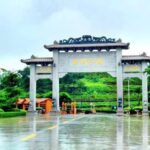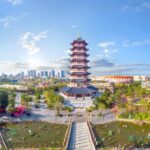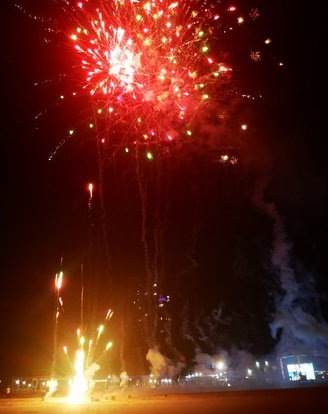In the eastern part of Guangdong Province, to the south of Sangpu Mountain, lies Xiangshan. The geomancers say: ‘The end of the nose, facing south with perilous rocks, is the nose-lip; beneath the lip, two hidden stones are the crab’s eyes; in front of them, an old house stands for the crab’s body; because of its low-lying location, it is called the stable muddy crab.’ This old house, named ‘Balan Hall’, has a study room on its right named ‘Virtuous Neighbor’, said to be built by Chundu during the Qing Kangxi and Yongzheng periods, with a history of 300 years. Not far from it, there is a ‘Chundu Gong Ancestral Hall’, built in memory of Zheng Wenhai. This group of ancient residential buildings has been listed by Jieyang City as the fifth batch of municipal cultural relics protection units. When mentioning the ancient residential cluster at Sha Chiwei in Fengmei Village, Didu Town, one naturally thinks of Zheng Wenhai, also known as Chundu, a scholar in the local dialect. Zheng Wenhai was good at managing household affairs and aiding others, never sparing his wealth for the benefit of others. In the past, to the south of Zoutang, there was a vast expanse of foreign fields. This boundless Banyan River alluvial land has been formed for a long time. But in the long historical process, because there was no river embankment to resist saltwater and no perfect drainage system, it has always been a low-yield paddy field. When drought occurs, the salinity increases, and it can even be uncultivated for several years. Zheng Wenhai then dredged deep ditches inside and built long embankments outside, taking on the task himself, regardless of the cost. He turned it into a good field that was drought and flood-resistant, becoming the granary of Zoutang – which is also the material basis for the prosperity of this Chaoshan prominent family. Didu Town has 40,000 acres of paddy fields, and this area accounts for one-third of it. To this day, it is still the place where the vast majority of people in the coastal area of Jiedong Didu benefit from ‘clothing and food’. It can be said that without Zheng Wenhai, the ancestral hall would not be named ‘Chundu’, and without Zheng Wenhai leading the people to open the stream, turning thousands of acres of barren beach land into high-yield good fields, realizing the great change of fate ‘how can the blue sky be like a person’, the ancestral hall dedicated to Zheng Wenhai would not be so solemn and respectful. According to experts and scholars: The wood carvings and stone carvings in the ancestral hall are exquisitely crafted, and can be regarded as representative works of the mature period of Chaoshan architectural decoration. The richly composed and elegantly colored beam paintings are also not something that ordinary craftsmen of the time could accomplish, it is obvious that it should be the work of a master. In the era of Zoutang Zheng’s family, when natural disasters were endless and wars were imminent, to invest considerable funds to build this ancestral hall in memory of the sages, there is only one absolute affirmation, that is their devout worship of their ancestors. It is this kind of ancestor worship that motivates them to do their best, meticulously. Such a behavior, formed by the worship of the sages, its seriousness and strictness, cannot be replaced by other attitudes. For this reason, Zheng Wenhai is a famous person of his generation, and the Chundu Gong Ancestral Hall dedicated to him has become a magnificent architectural masterpiece.
Walking in this group of ancient residential complexes is like walking into an elegant and comfortable courtyard… Looking at the inlaid porcelain, wood carvings, and stone carvings, they are brightly colored and eye-catching, exquisitely carved. On the cornices and painted pillars, there are painted flowers, birds, fish and insects, birds and beasts, opera stories or historical figures, vivid and lifelike. Some people say that architecture is frozen history. And this group of residential buildings just verifies the historical process of Chaoshan people’s reproduction, struggle and progress for thousands of years. The wood carvings and stone carvings in the ancestral hall are extremely exquisite and can completely become representative works of the mature period of Chaoshan architectural decoration. The specific business status and opening hours are subject to the opening situation on that day.









